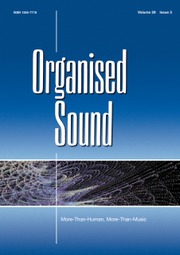No CrossRef data available.
Article contents
The Biophilic Instrument Pavilion: Spatialisation across disciplines
Published online by Cambridge University Press: 08 October 2025
Abstract
This article explores biophilic (nature-centred) instrument design and its intersection with architecture and music. While the connection between these disciplines is often discussed figuratively, they are less often combined in practice. The Biophilic Instrument Pavilion (BIP), a site-responsive sound and light installation, serves as a model for such a collaboration using biophilic design as a unifying principle. This multidisciplinary project demonstrates spatialisation in ecological, sonic, visual and social contexts, offering insights into environmental instrument practices and collaborative creative processes.
Information
- Type
- Article
- Information
- Copyright
- © The Author(s), 2025. Published by Cambridge University Press
References
References
Adams, D. and Beauchamp, G. 2019. Spiritual Moments Making Music in Nature. A Study Exploring the Experiences of Children Making Music Outdoors, Surrounded by Nature. International Journal of Children’s Spirituality 24(3): 260–75. https://doi.org/10.1080/1364436X.2019.1646220.CrossRefGoogle Scholar
Beatley, T. 2017. Biophilic Cities and Healthy Societies. Urban Planning 2(4): 1–4. https://doi.org/10.17645/up.v2i4.1054.CrossRefGoogle Scholar
Beaumont, T. 2016. Ellen Fullman: How to Play a 100ft Stringed Instrument. The Guardian, 1 March. www.theguardian.com/music/2016/mar/01/100-foot-instrument-long-string-ellen-fullman (accessed 20 March 2025).Google Scholar
Bedewy, S., Lavicza, Z. and Lyublinskaya, I. 2024. STEAM Practices Connecting Mathematics, Arts, Architecture, Culture and History in a Non-Formal Learning Environment of a Museum. Nournal of Mathematics and the Arts 18(1–2): 101–34. https://doi.org/10.1080/17513472.2024.2321563.CrossRefGoogle Scholar
Bianchi, F. and Manzo, V. J. 2016. Environmental Sound Artists: In their Own Words. New York: Oxford University Press.Google Scholar
Bryant, A. 2016. Tobi Lütke of Shopify: Powering a Team with a ‘Trust Battery’. New York Times, 22 April 2016. www.nytimes.com/2016/04/24/business/tobi-lutke-of-shopify-powering-a-team-with-a-trust-battery.html?smid=url-share (accessed 23 March 2025).Google Scholar
Chafe, C. 2007. Tomato Quintet. Music from tomatoes in a sound art installation. https://chrischafe.net/tomato-quintet/ (accessed 10 September 2025).Google Scholar
Cheetham, M. 2018. Landscape into Eco Art: Articulations of Nature Since the ’60s. University Park, PA: Pennsylvania State University Press.Google Scholar
Colorusso, C. 2011. Sun Boxes. Portable installation. www.craigcolorusso.com/works/sunboxes/ (accessed 10 September 2025).Google Scholar
Cortez, A. 2023. Sound as a Producer of Social Spaces in Museum Exhibitions. Curator: The Museum Journal 66(2): 221–381. https://onlinelibrary.wiley.com/doi/full/10.1111/cura.12547.
CrossRefGoogle Scholar
Dadson, P. 2022–23. Kōea o Tāwhirimātea: Weather Choir. www.circuit.org.nz/work/k-ea-o-tawhirimatea-weather-choir-voicing-the-wind (accessed 10 September 2024).Google Scholar
De Maria, W. 1977. The Lightning Field. Long-Term installation in Catron County, New Mexico, maintained by the Dia Art Foundation.Google Scholar
Eliasson, O. 2007. Slow Solar Event. Installation. https://olafureliasson.net/artwork/slow-solar-event-2023/ (accessed 10 September 2025).Google Scholar
Exploratorium. n.d. The Wave Organ. www.exploratorium.edu/visit/wave-organ (accessed 20 March 2025).Google Scholar
Fromm, E. 1973. The Anatomy of Human Destructiveness. New York: Holt, Rinehart and Winston.Google Scholar
Hayes, L. and Stein, J. 2018. Desert and Sonic Ecosystems: Incorporating Environmental Factors within Site-Responsive Sonic Art. Applied Sciences 8(1): https://doi.org/10.3390/app8010111.CrossRefGoogle Scholar
Herndon, J. 2021. Shadow Prism. www.julieherndonmusic.com/shadow-prism (accessed 10 September 2024).Google Scholar
Hodgson, I., Hoffmann, D., Junge, L., Theis, F. and Dittgen, N. 2024. Learning to Listen Properly: Participatory Digital Projects at the German Maritime Museum Based on Iterative Co-creation. Association for Computing Machinery: Journal on Computing and Cultural Heritage 17(3). https://doi.org/10.1145/3656585.Google Scholar
Hunter, G. 2021. Designing Digital Musical Instruments: Adopting an Ecological Lens to Identify Design Considerations. Companion Publication of the 2021 ACM Designing Interactive Systems Conference. New York: ACM, 33–5. https://doi.org/10.1145/3468002.3468238.CrossRefGoogle Scholar
Huntsman, D. and Bulaj, G. 2022. Healthy Dwelling: Design of Biophilic Interior Environments Fostering Self-Care Practices for People Living with Migraines, Chronic Pain, and Depression. International Journal of Environmental Research and Public Health, 19(4): 2248.CrossRefGoogle ScholarPubMed
Kallmyer, C. 2014. Los Angeles Department of Weather Modification. http://www.chriskallmyer.com/works/los-angeles-department-of-weather-modification/ (accessed 10 September 2024).Google Scholar
Kellert, S., Mador, M. and Heerwagen, J. 2008. Biophilic Design: The Theory, Science, and Practice of Bringing Buildings to Life. Hoboken, NJ: Wiley.Google Scholar
Khine, M. and Areepattamannil, S. (eds.) 2019. STEAM Education: Theory and Practice. Cham, Switzerland: Springer.CrossRefGoogle Scholar
Lefebvre, H. [1991] 1974. The Production of Space, trans. D. Nicholson-Smith. Oxford: Blackwell.Google Scholar
Low, M. 2016. The Sociology of Space: Materiality, Social Structures, and Action. New York: Palgrave Macmillan.CrossRefGoogle Scholar
Matthews, E-K. 2019. Activating Audiences: How Spatial Music can Help us to Listen. Organised Sound 24(3): 297–306. https://doi.org/10.1017/S1355771819000360.CrossRefGoogle Scholar
Mills, R. 2016. Sound Prism. Installation in Bogota, Colombia. https://rucyl.com/_Sound-Prism (accessed 10 September 2025).Google Scholar
Ness, I. J. 2018. Behind the Scenes: How to Research Creative Processes in Multidisciplinary Groups. In Lebuda, I. and Glăveanu, V. P. (eds.) The Palgrave Handbook of Social Creativity Research. Cham, Switzerland: Palgrave Macmillan. https://doi.org/10.1007/978-3-319-95498-1_22.Google Scholar
Richards, P. and Gonzalez, G. 1986. Wave Organ. San Francisco, CA: installation. www.peterrichardsart.com/wave-organ.html (accessed 10 September 2024).Google Scholar
Robertson, D., Martin, D. and Singer, P. 2003. Interdisciplinary Research: Putting the Methods Under the Microscope. BMC Medical Research Methodology 3(20). https://doi.org/10.1186/1471-2288-3-20.CrossRefGoogle ScholarPubMed
Silvia, P., Fayn, K., Nusbaum, E. and Beaty, R. 2015. Openness to Experience and Awe in Response to Nature and Music: Personality and Profound Aesthetic Experiences. Psychology of Aesthetics, Creativity, and the Arts 9(4): 376–84. https://doi.org/10.1037/aca0000028.CrossRefGoogle Scholar
Solomos, M. 2023. Exploring the Ecologies of Music and Sound: Environmental, Mental and Social Ecologies in Music, Sound Art and Artivisms. Abingdon: Routledge.Google Scholar
Truax, B. 1996. Soundscape, Acoustic Communication and Environmental Sound Composition. Contemporary Music Review 15(1–2): 49–65. https://doi.org/10.1080/07494469608629688.CrossRefGoogle Scholar
Turrell, J. 1970–present. SkySpace. https://hypercritic.org/collection/james-turrell-skyspace-1-1976-meaning-review (accessed 10 September 2024).Google Scholar
Turrell, J. 1979–present. Roden Crater Project. Installation. https://www.guggenheim.org/artwork/4095 (accessed 12 September 2025).Google Scholar
Valdez, H. 2022. Biophilic Architecture Used to Improve Patient Outcomes and Recovery in Behavioral Health Centers. Thesis, Rochester Institute of Technology. https://repository.rit.edu/theses/11296/ (accessed 10 September 2024).Google Scholar
Vickers, D. 2021. A Biophilic Architecture Typology for Mental Health. Thesis, Pennsylvania State University. https://honors.libraries.psu.edu/files/final_submissions/7624 (accessed 10 September 2024).Google Scholar
Walshe, N., Lee, E., Lloyd, D. and Sapsed, R. 2019. STEM to STEAM as an Approach to Human Development: The Potential of Arts Practices for Supporting Wellbeing. In Burnard, P. and Colucci-Gray, L. (eds.) Why Science and Art Creativities Matter: (Re-)Configuring STEAM for Future-making Education. Leiden: Brill Sense, 338–57. https://doi.org/10.1163/9789004421585_019.Google Scholar
Younge, B. 2023. Atavist II. Composition for 4 performers and electronics. https://bethanyyounge.com/collection-4 (accessed 12 September 2025).Google Scholar


